From the time of liberation to integration, Washington Street flourished into the economic stronghold of the Black community in Columbia.
In the segregated South, Black Columbians could head to Washington Street and buy their groceries, hire a lawyer, catch a show, get their hair done or go shopping. It was all in one short stretch of centrally located blocks. On one end of the street, Zion Baptist Church served as the meeting place for the Civil Rights Movement in Columbia; on the other end, Sarah Mae Fleming sat in the ‘Whites Only’ section of a city bus, prompting a landmark lawsuit and the desegregation of public transportation in Columbia.
Then came progress.
White-only Main Street businesses were forced to integrate after months of sit-ins and peaceful protests began by college students from Allen and Benedict Universities in the early 1960s.

Bobby Donaldson, second from right, is the lead scholar of the Columbia SC 63 Project and the USC Center for Civil Rights. The organizations collaborated with the Columbia Museum of Art to create the Our Story Matters Galley.
A victory for inclusion and Civil Rights citywide, integration also had “unintended consequences,” according to Bobby Donaldson, who leads USC’s Civil Rights Center and is the lead scholar of the Columbia SC 63 Project.
“What you see (downtown) after African Americans are successful in breaking down racial barriers and the white commercial district,” Donaldson told The Free Times. “So much so that when African Americans now have access to other businesses, theaters and restaurants, one of the unintended consequences is that it leads to the decline of the Black Business community.”
But now, Donaldson and his team are recreating the lost history of Washington Street at the Our Story Matters Gallery, a collaboration between the USC Center for Civil Rights History and Research, Columbia SC 63 and the Columbia Museum of Art. The free, permanent exhibit inhabits the former giftshop space in the museum’s lobby on Main Street.
In addition to tracing the economic power once held on Washington Street, the exhibit highlights people and places that were integral to the Civil Rights’ Movement in Columbia.

The Our Story Matters Gallery in the Columbia Museum of Art
“This exhibit demonstrates a remarkable progress, but also demonstrates this progress was not inevitable,” Donaldson explained.
As he discussed the decade-plus of work he and his team have done to share this history — most of which had never been compiled or published prior to Donaldson’s research — Donaldson pointed out the framed photos lining the exhibit walls.
The images are from the collection of photographer Richard Samuels Roberts, who captured life in Columbia’s Black community in his home studio and in the community.

The Our Story Matters Gallery examines the history of Columbia’s Black business district, and the Civil Rights Movement that spurned around it.
“Upon his death, his family put his negatives under his crawlspace,” Donaldson said of the extensive collection, which has been printed and preserved by USC. “They remained there for about four decades.”
The photographs largely include unknown people — children, families and business owners who lived and toiled in Columbia during the middle of the 20th Century. Donaldson hopes that they’ll be able to find some of the people in the photographs.
Stalwarts of Columbia Civil Rights Movement are also featured in the exhibit, from famed activist and leader Modjeska Simkins’ swing coat to a photo of John McCray, a 1940s newspapermen who used his paper, “The Lighthouse and Informer,” to spread the word about voting rights, happenings in the Black community and political meetings.

Our Story Matters Gallery in the Columbia Museum of Art
The exhibit will become a part of the Columbia SC 63 Main Street tours, which trace the history of Civil Rights in Columbia from the Statehouse to City Hall.
And while the exhibit is slated as a permanent fixture of the art museum’s lobby space (no admission required, either), Donaldson hopes to see the once-forgotten stories of South Carolina Civil Rights leaders spread farther than Main Street.
“This is to give people a sense of what’s possible,” Donaldson said.
The Our Story Matters Gallery is open during regular Columbia Museum of Art business hours and is free to access from the museum lobby.




